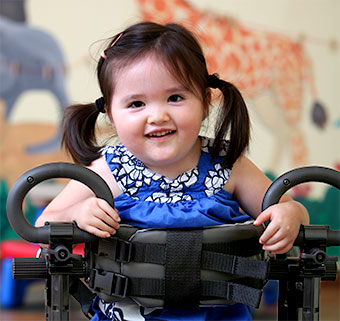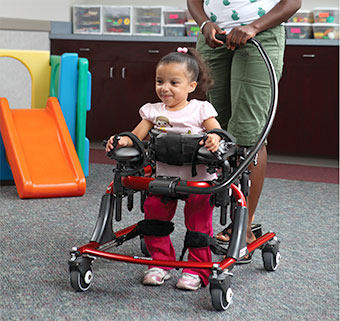I recently attended the annual American Physical Therapy Association Combined Sections Meeting (APTA CSM) in New Orleans. Among the wealth of great programming, I chose a course looking at early intervention for children with cerebral palsy (CP), and I’d like to share a few points I took away.
 For therapy purposes, early intervention means providing services to a child before two years of age. Although the body of evidence for the benefits of intervening early in children with CP continues to accumulate, the diagnosis of CP and the indication to intervene is not usually immediately forthcoming. This then amounts to the loss of a valuable window of opportunity for intervention. So how can we as therapists identify the children who need our services earlier?
For therapy purposes, early intervention means providing services to a child before two years of age. Although the body of evidence for the benefits of intervening early in children with CP continues to accumulate, the diagnosis of CP and the indication to intervene is not usually immediately forthcoming. This then amounts to the loss of a valuable window of opportunity for intervention. So how can we as therapists identify the children who need our services earlier?
Ginny Paleg, PT, DScPT, MPT, one of the course presenters, told how, in her Maryland-based early intervention work, she uses the General Movement Assessment (GMA) to identify infants with biomarkers of CP before 3 months, and the Hammersmith Infant Neurological Exam (HINE) to identify children who need specific rehabilitation programs before three months of age. Both the GMA and the HINE have emerged as having high accuracy in identifying these infants. And the predictive value is even better when combined with neuroimaging data. 1,2
These screening tools allow Paleg to identify young children who need referral to CP-specific physicians and who should receive early intervention to optimize neuroplasticity and prevent complications later on (such as constraint-induced movement therapy and hip surveillance). The diagnosis of CP is important because these infants benefit from different early interventions than infants with diagnosis such as “developmental delay.”
CP Specific Early Interventions
The JAMA Pediatric article “Early, Accurate Diagnosis and Early Intervention in Cerebral Palsy” spells out some of the promising results of CP-specific early intervention:2
1. Infants with hemiplegic CP receiving early CIMT have better hand function than controls in the short and long term.
2. Infants with bilateral CP receiving regular hip surveillance and intervention have lower rates of hip displacement, contracture and scoliosis
3. All infants with CP receiving early, intense, task-specific training at home have better motor and cognitive skills at one year of age than those receiving standard care.
4. Improvements are best when early CP intervention occurs in the supported natural environment of the home.
And a multidisciplinary approach to addressing CP in infancy (as opposed to single-service provider model) is recommended to provide the most comprehensive care between all the disciplines needed to intervene.
 Another benefit of the HINE is the use of its cutoff scores to predict GMFCS levels at 9 months of age. This predictive quality should be applied judiciously as developmental motor skills and brain changes may result in reclassification of GMFCS level later on.2 However, Paleg pointed that this information is valuable for early acquisition of adaptive equipment needed to support gross motor skills, task specific intervention and standing protocols for hip integrity. She emphasized how critical it is that children have some way to actively explore their environment whether it is in a gait trainer or powered wheeled mobility. She went on suggest that therapists should use the HINE and GMFM to predict the child’s equipment needs early on.
Another benefit of the HINE is the use of its cutoff scores to predict GMFCS levels at 9 months of age. This predictive quality should be applied judiciously as developmental motor skills and brain changes may result in reclassification of GMFCS level later on.2 However, Paleg pointed that this information is valuable for early acquisition of adaptive equipment needed to support gross motor skills, task specific intervention and standing protocols for hip integrity. She emphasized how critical it is that children have some way to actively explore their environment whether it is in a gait trainer or powered wheeled mobility. She went on suggest that therapists should use the HINE and GMFM to predict the child’s equipment needs early on.
Clinical Bottom Line
As therapists, we do not diagnose, but we have it in our skill set to perform motor assessments which guide the decision making process about which children need referral and appropriate intervention. Early identification of children at risk for CP leads to specific and timely interventions, including adaptive equipment acquisition, that can prevent progressing secondary impairments and improve overall quality of life.
References:
1. Maitre NL, Chorna O, Romeo DM, Guzzetta A. Implementation of the Hammersmith Infant Neurological Exam in high-risk infant follow-up program. Pediatr Neurol. 2016;65:31-8.
2. Novak I, Morgan C, Adde L, Blackman J, Boyd R, Brunstrom-Hernandez J, et al. Early, accurate diagnosis and early intervention in cerebral palsy. JAMA Pediatr. 2017;171(9):897-907.
** This post was originally published on http://www.rifton.com/adaptive-mobility-blog/blog-posts/2018/march/early-intervention-cerebral-palsy

